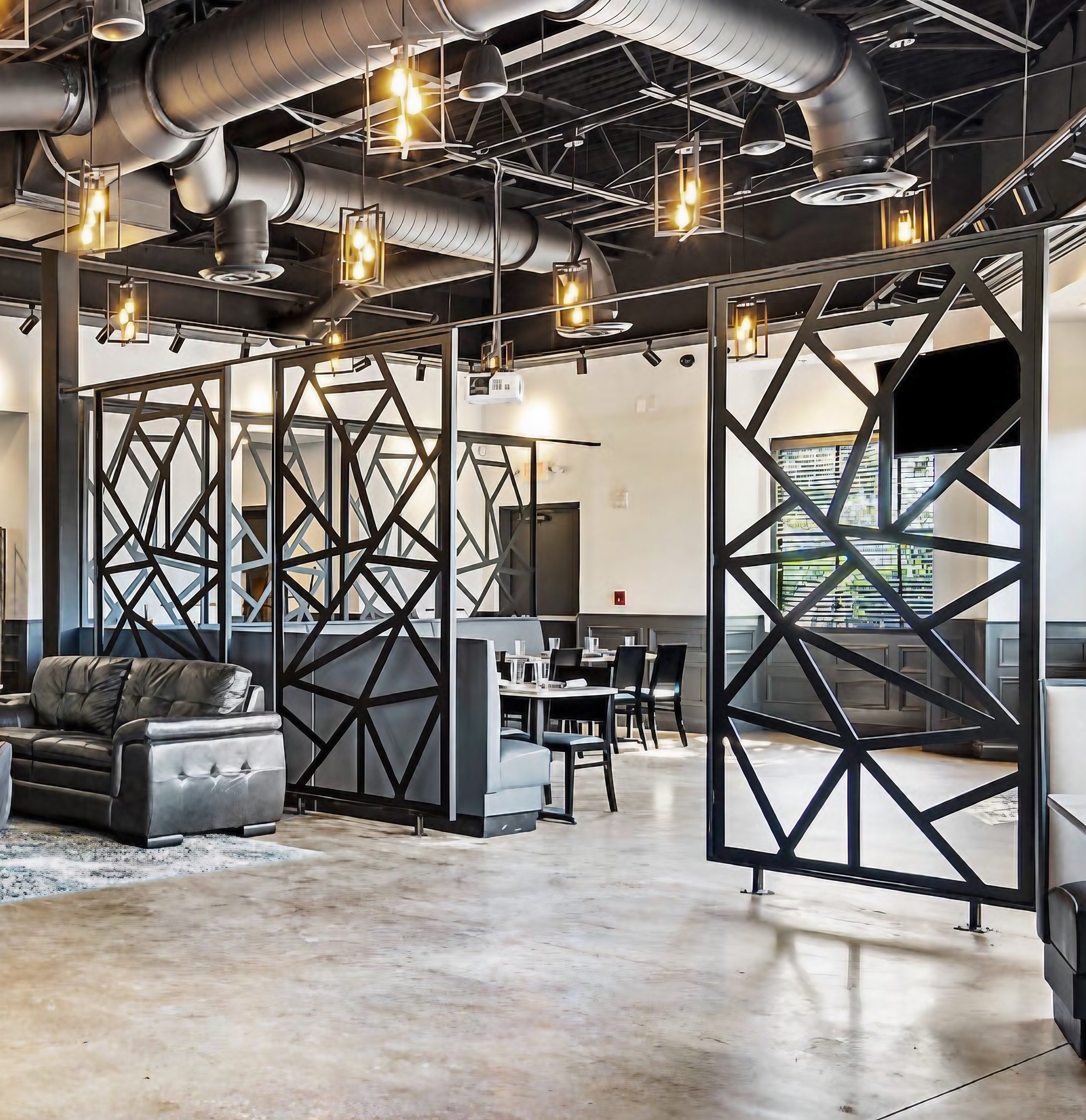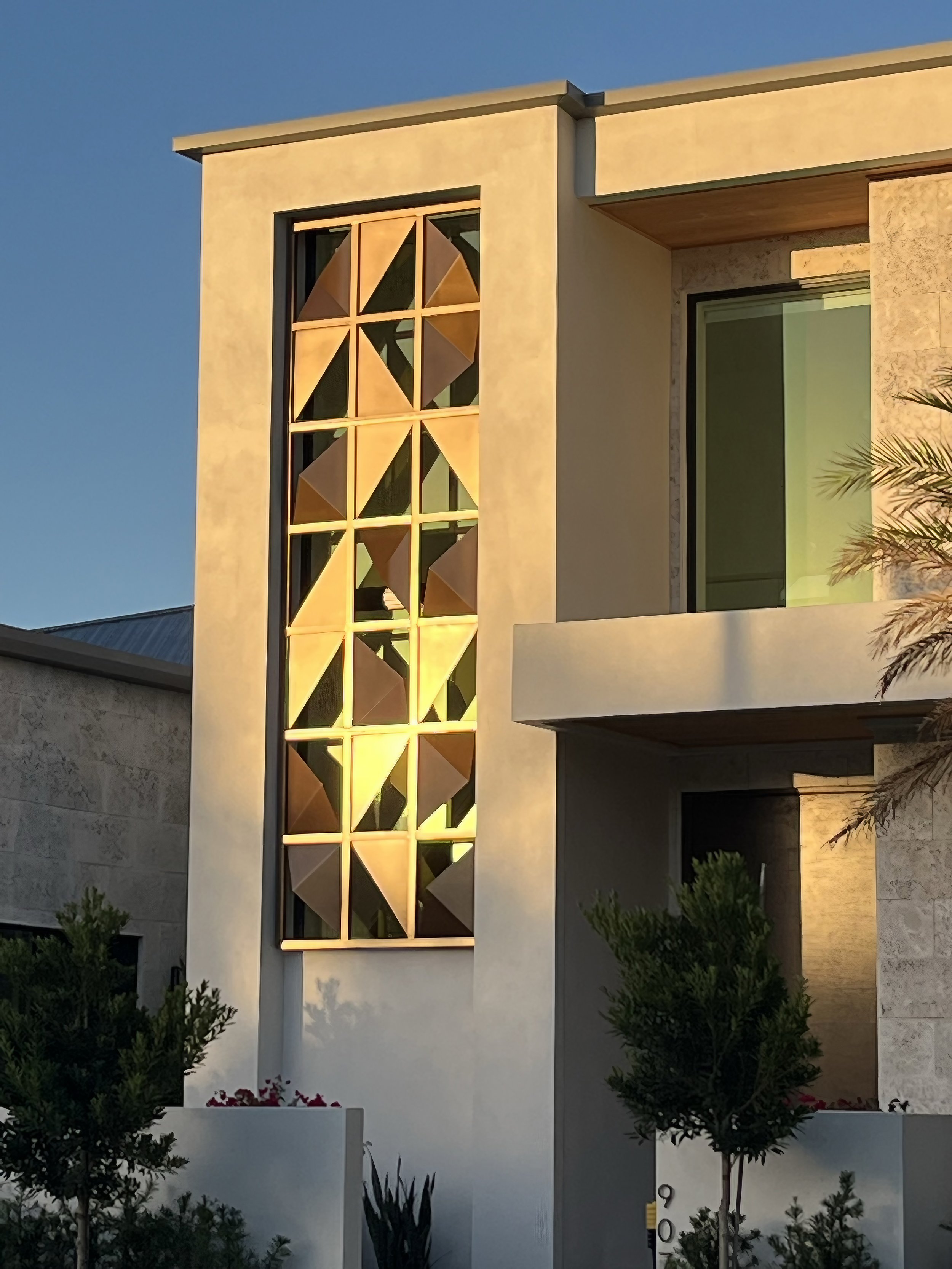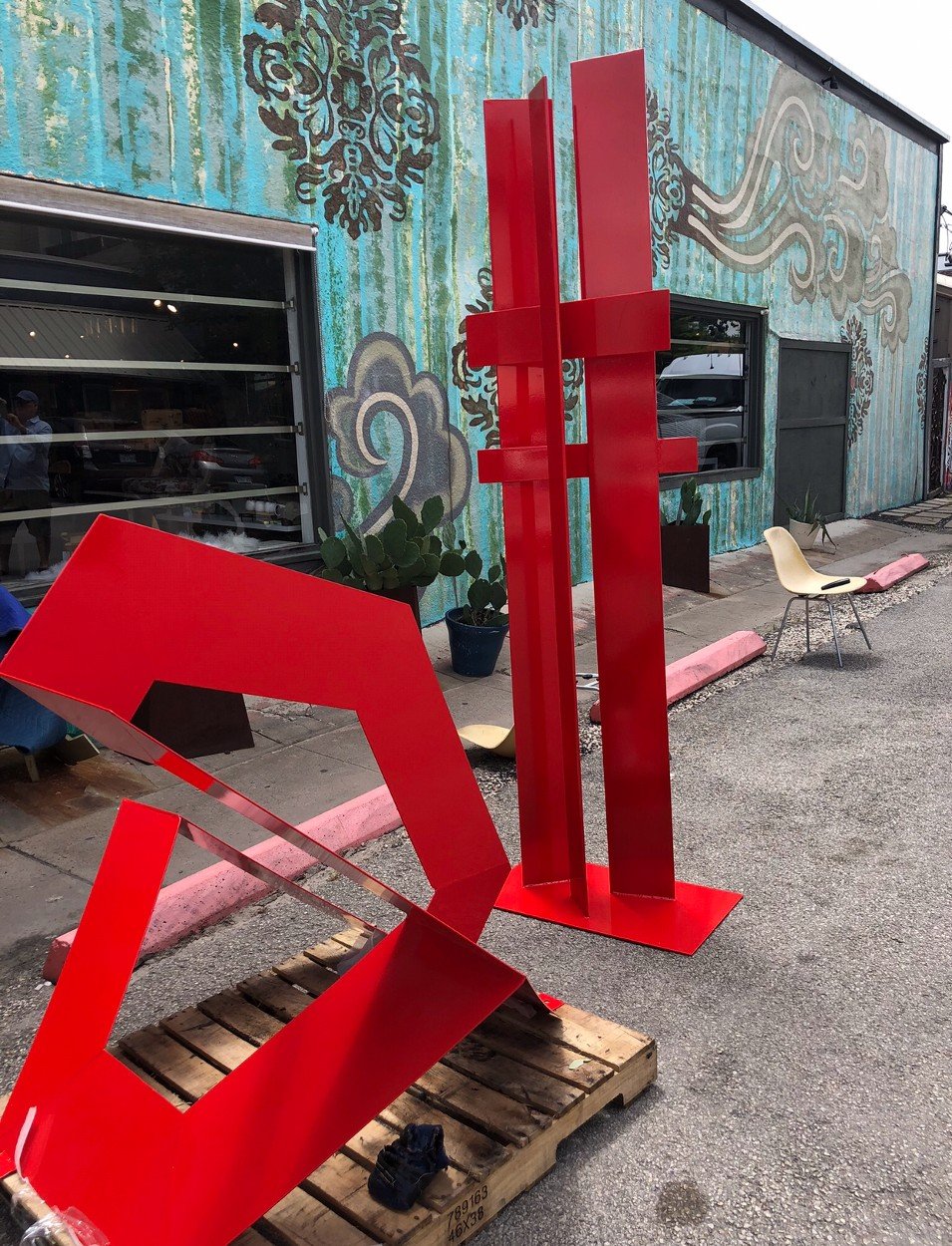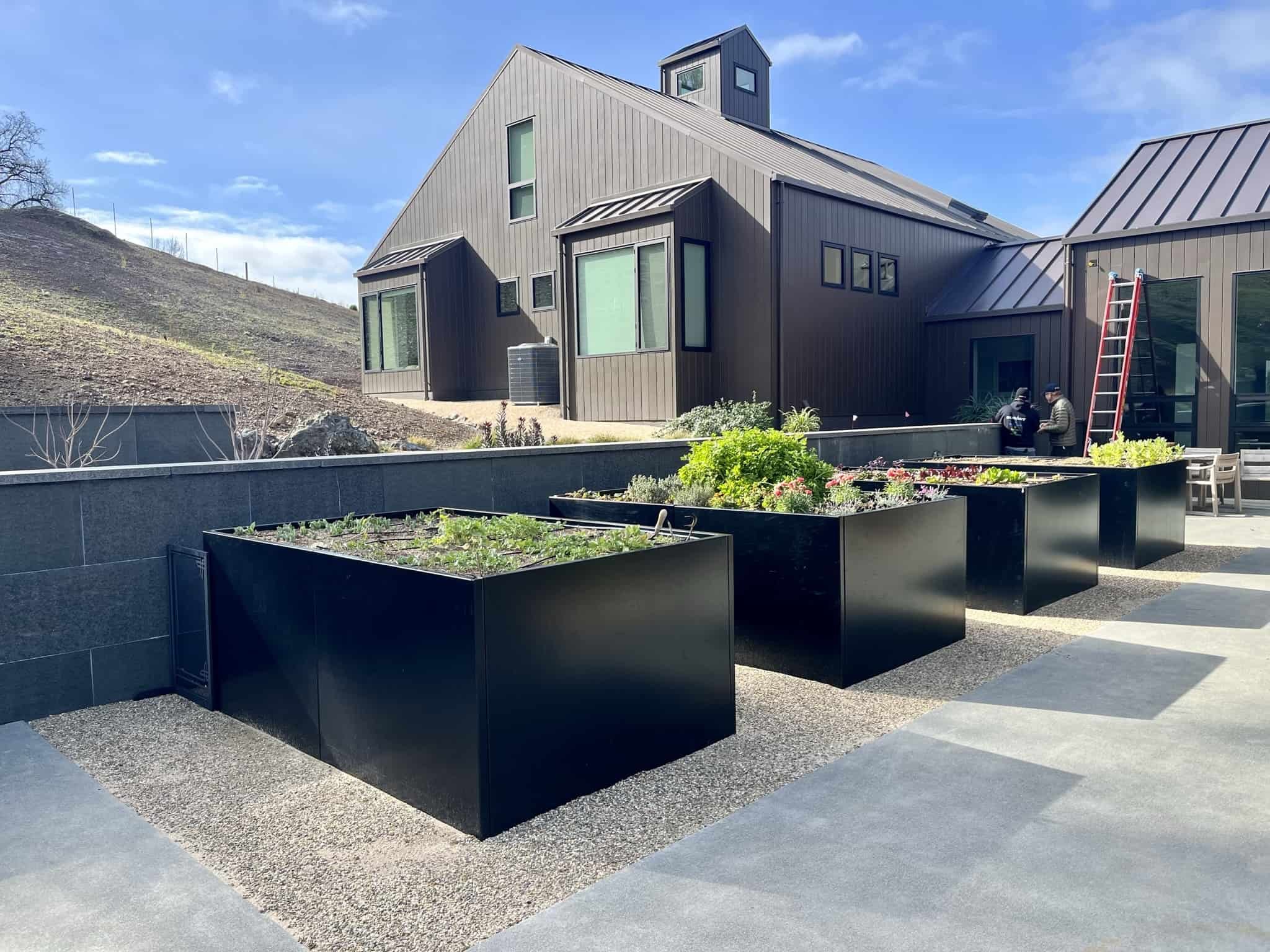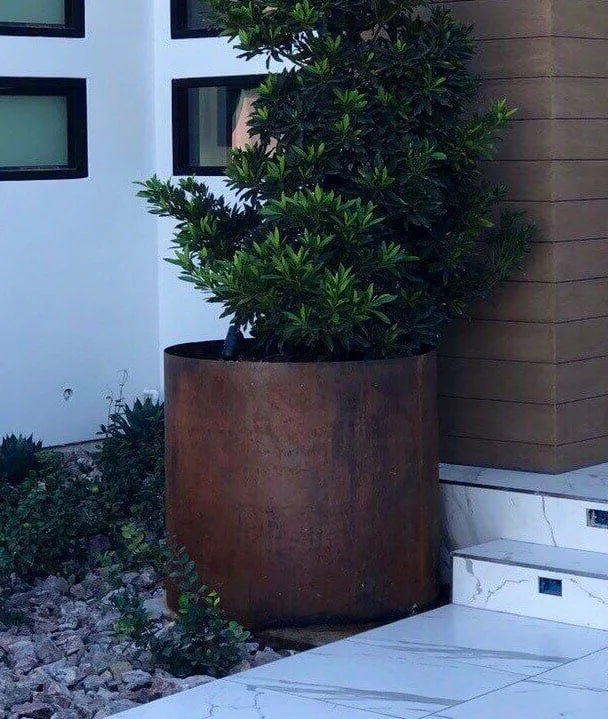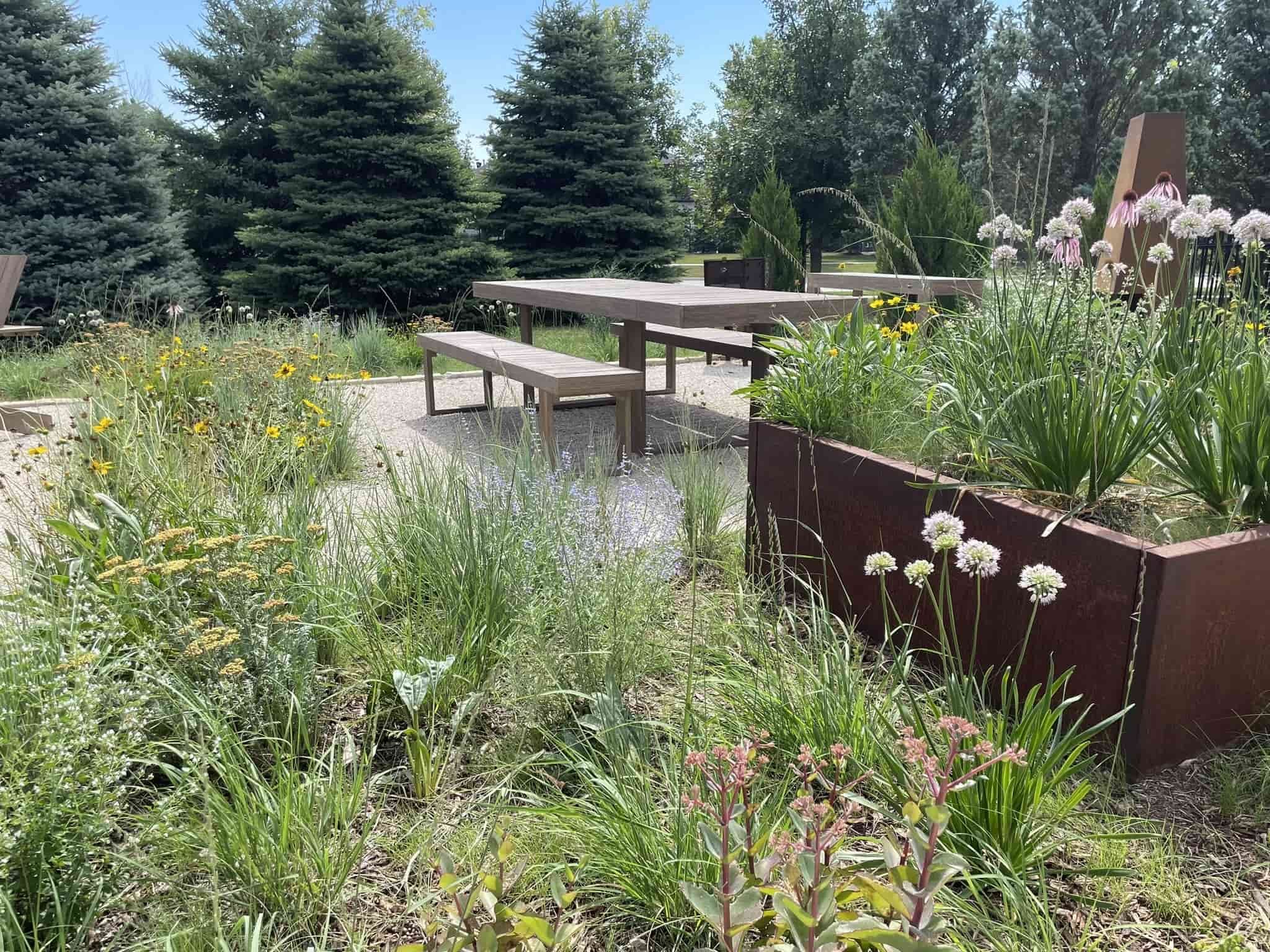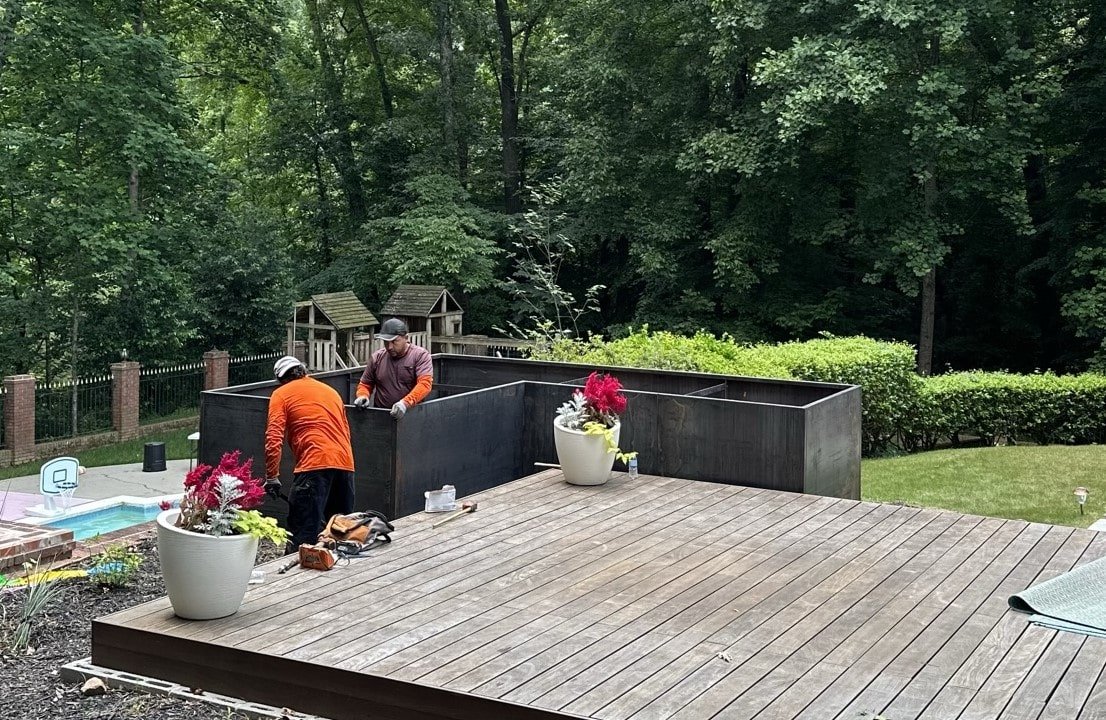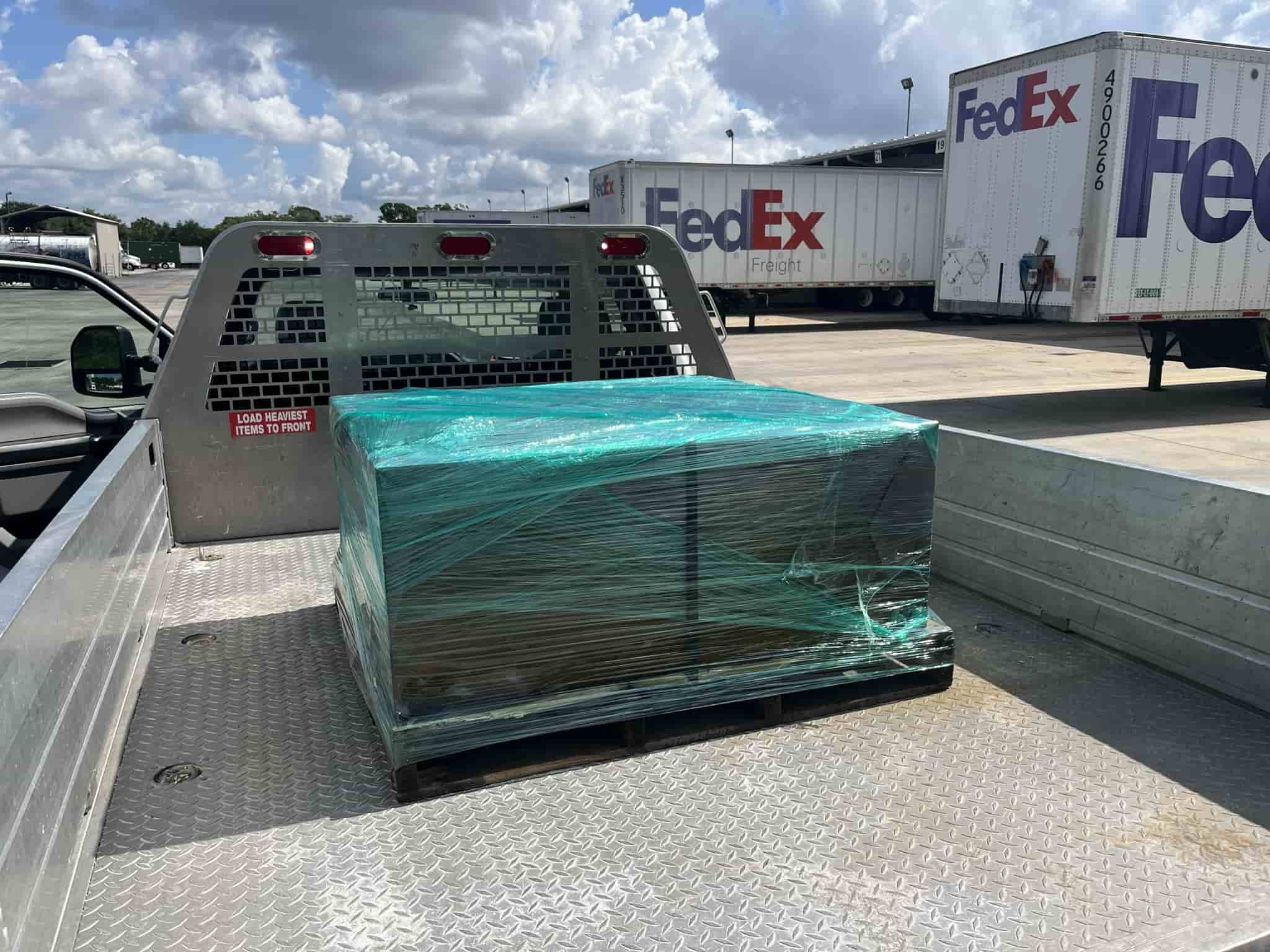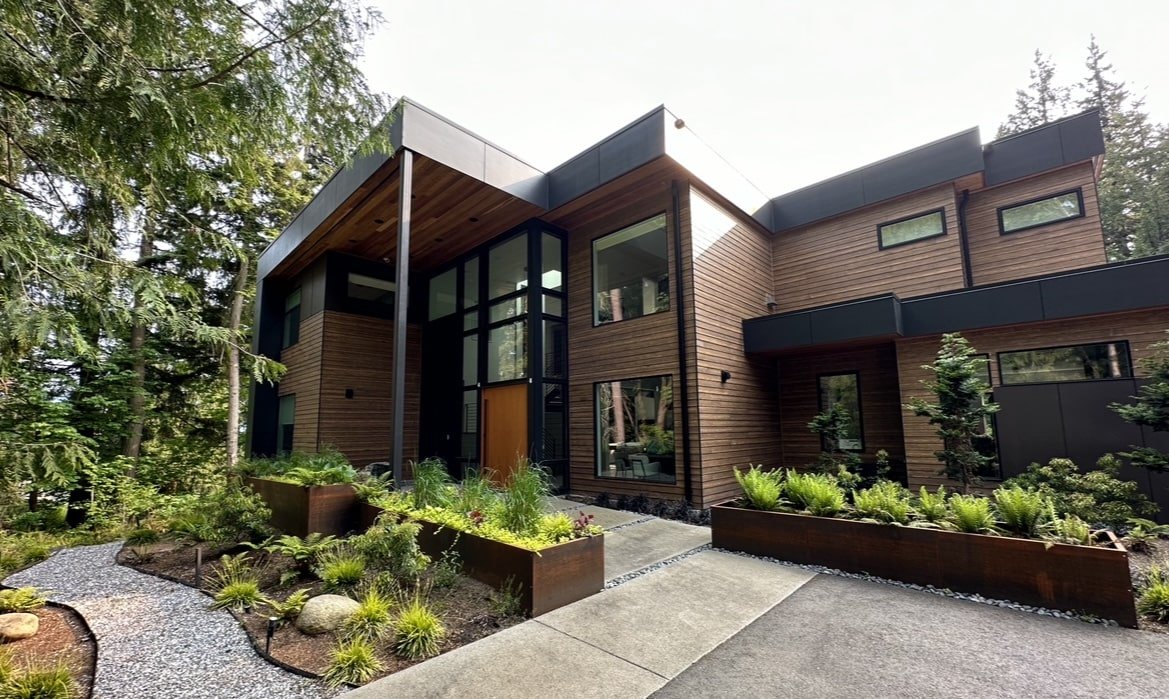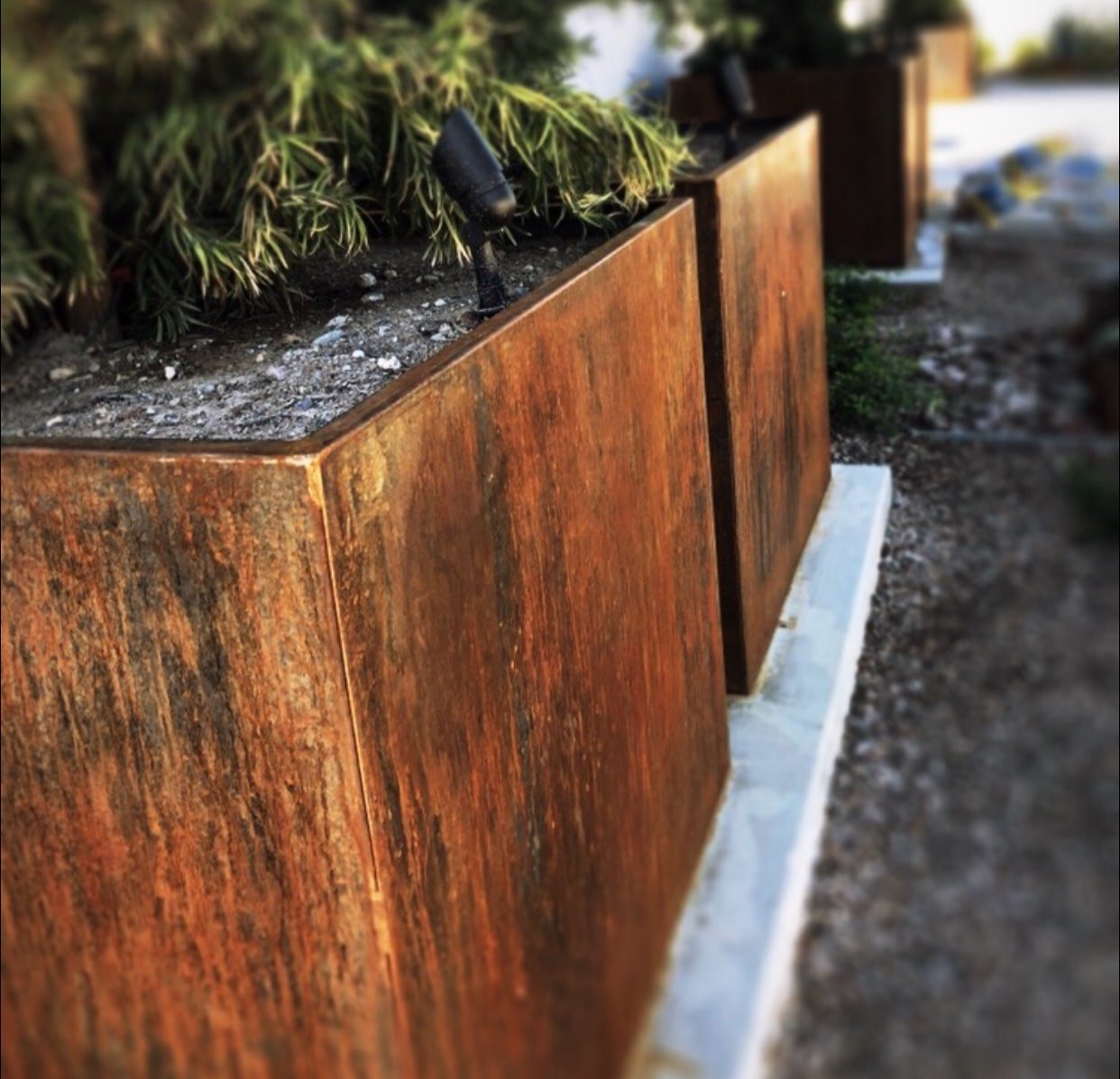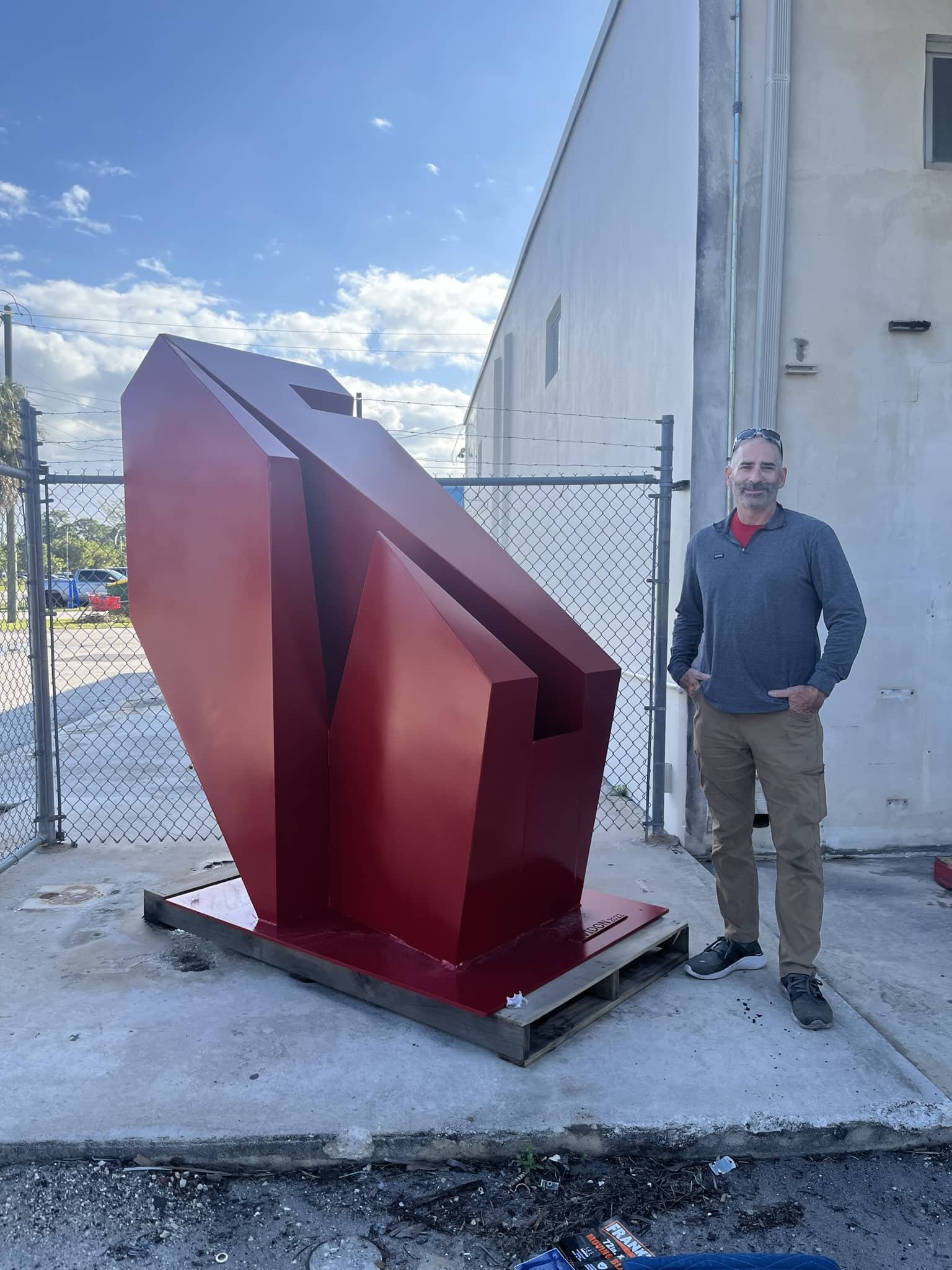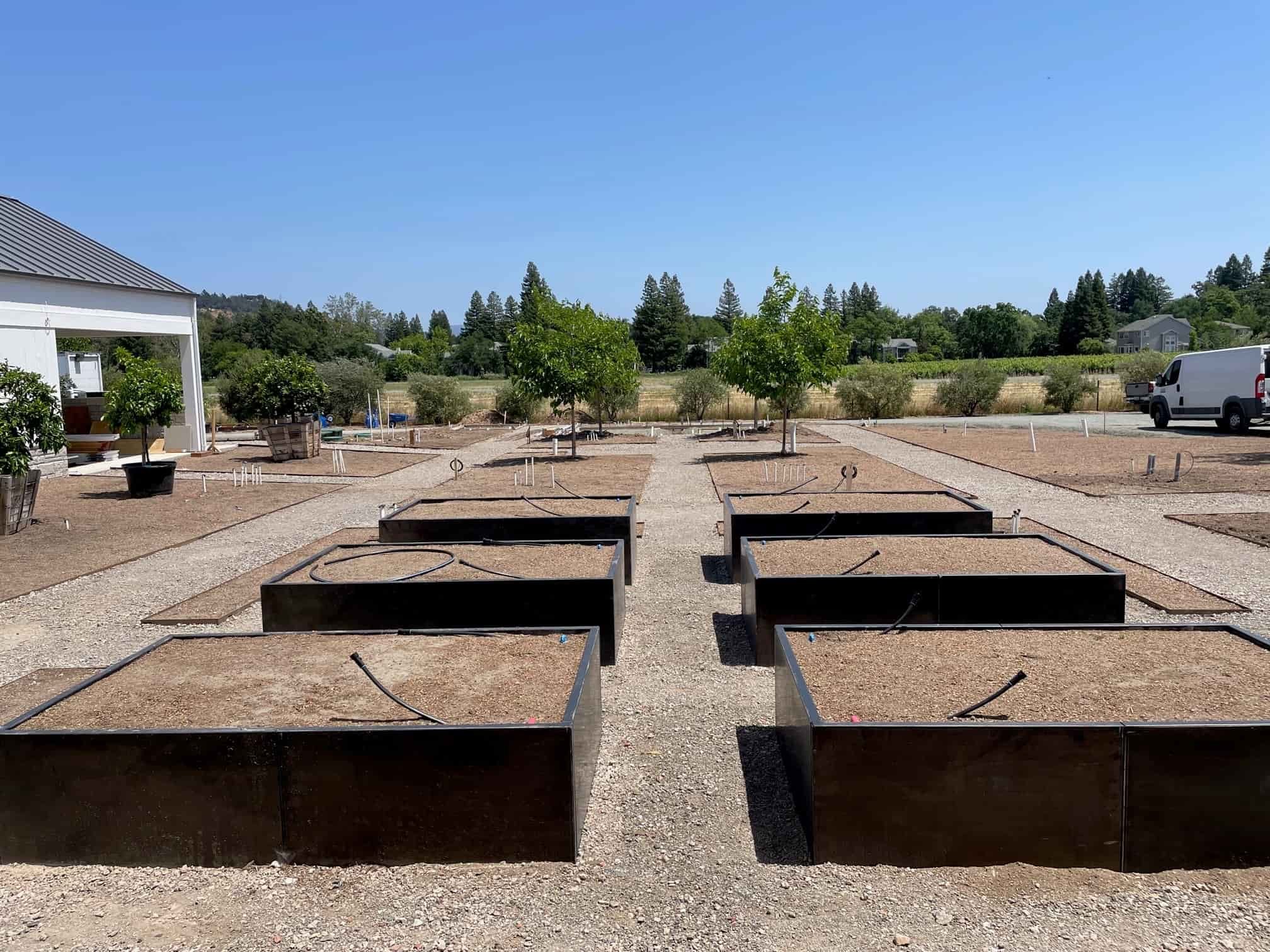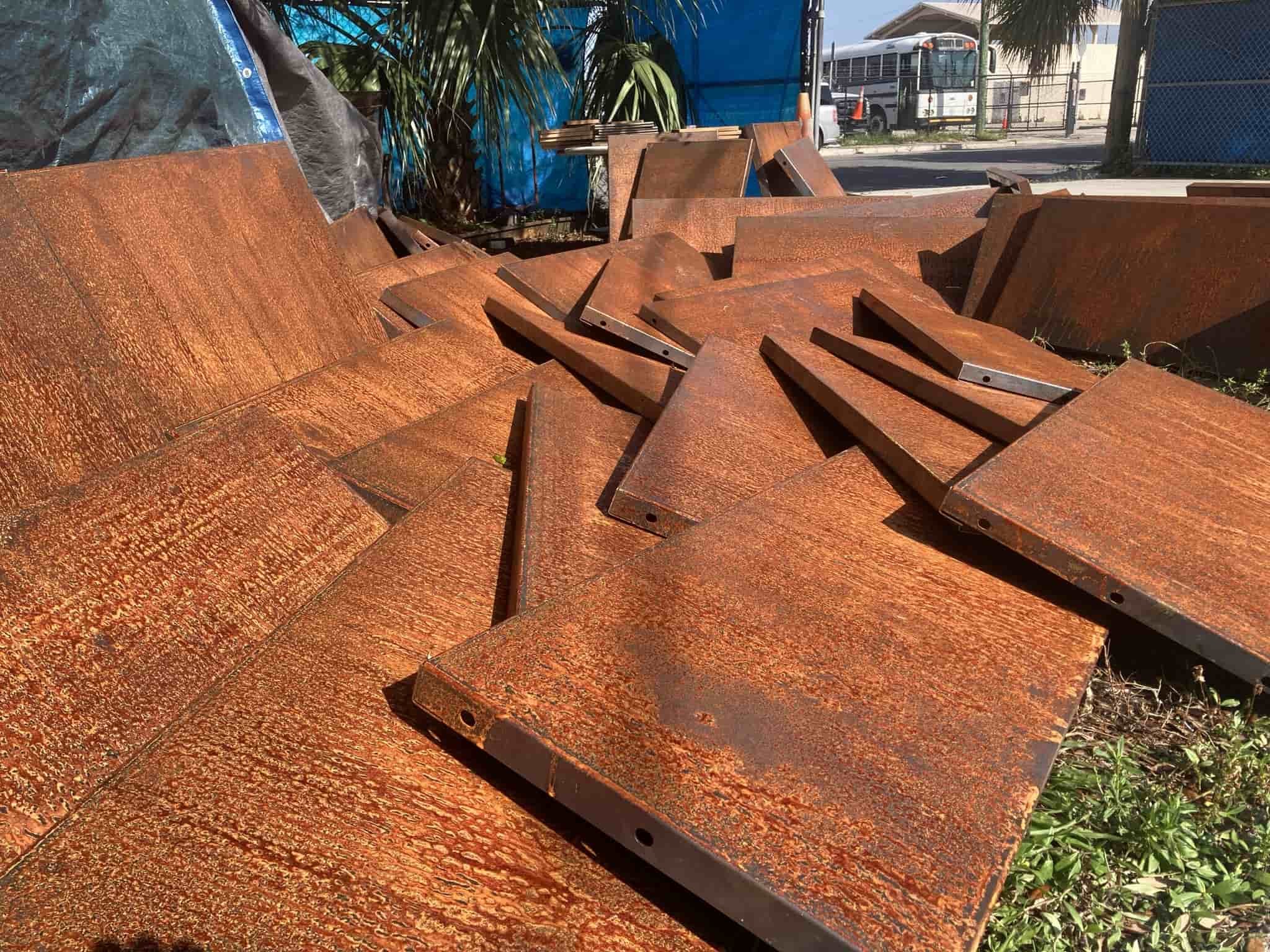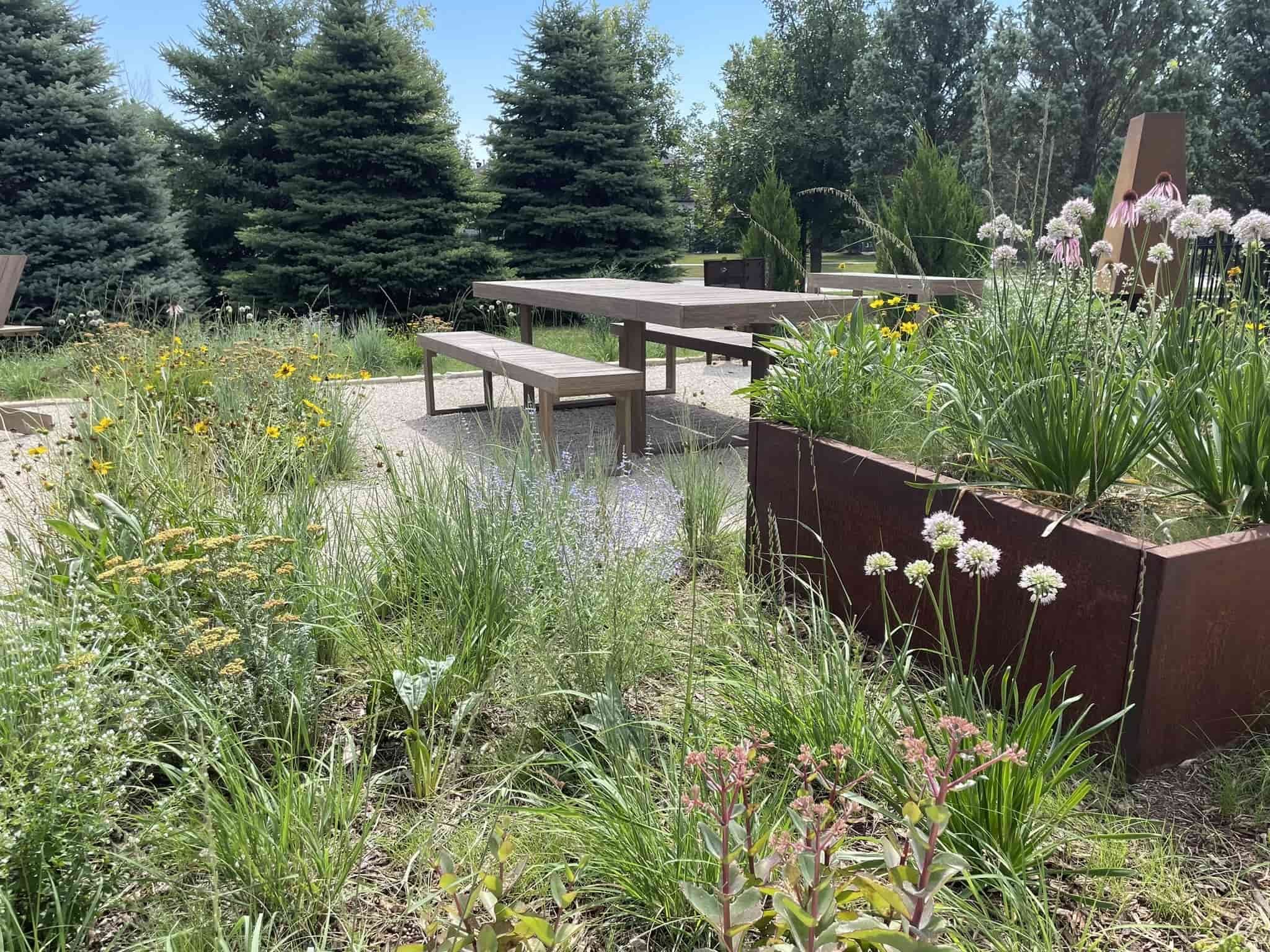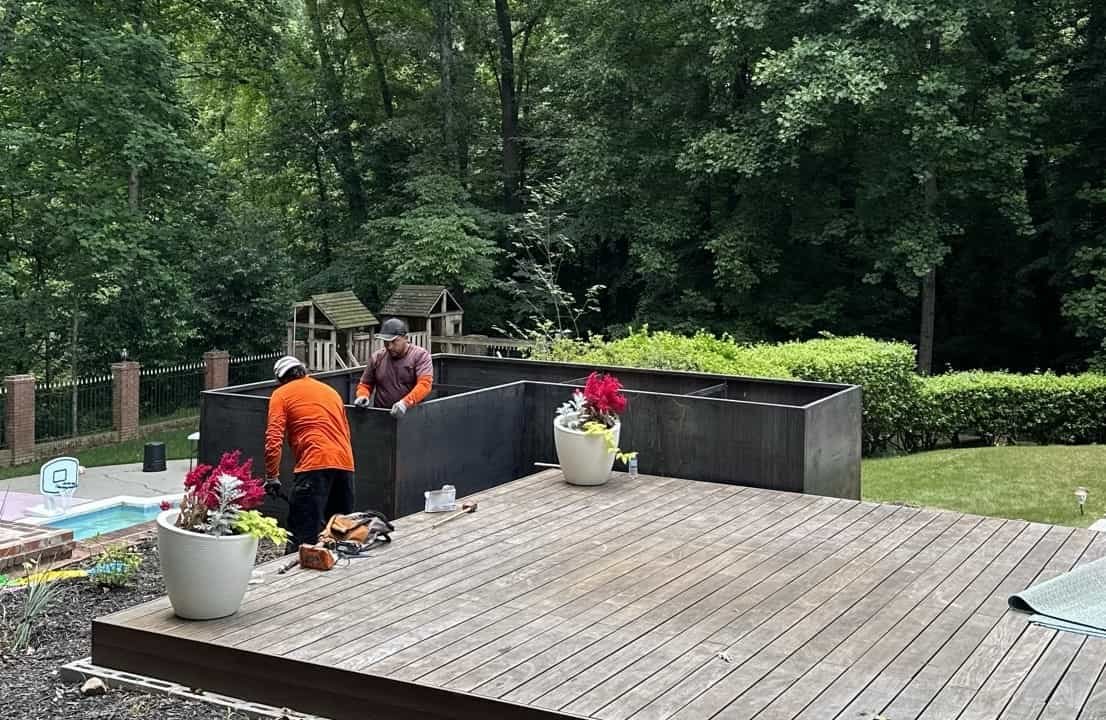Working with a Custom Metal Sculpture Designer to Bring Your Vision to Life
Corten steel planters - Top things to consider before buying them
When it comes to adding a touch of unique and personal flair to any space, there's nothing quite like a custom metal sculpture. These intricate and eye-catching pieces of art can elevate the aesthetic of any room, whether it be a home, office, or public space. However, finding the perfect custom metal sculpture for your space can be a challenge. That's where a custom metal sculpture designer comes in. In this blog post, we'll discuss the importance of working with a custom metal sculpture designer and the things you should consider before hiring one to bring your vision to life.
Understanding Your Needs: The Purpose and Position of Your Custom Metal Sculpture
When considering a custom metal sculpture for your space, it's important to first understand the purpose and position of the sculpture. Will it be an outdoor sculpture? What do you want it to convey? Is it meant to be a focal point or a complementary piece? Will it serve a functional purpose or purely aesthetic? These questions will help guide you in determining the size, shape, and design of the sculpture.
Additionally, understanding the position of the sculpture within the space is crucial. Will it be indoors or outdoors? Will it be mounted on a wall or displayed on a pedestal? Taking into account factors such as lighting, visibility, and surrounding elements will ensure that the sculpture enhances the overall ambiance of the space.
To bring your vision to life, working with a custom metal sculpture designer is essential. A skilled designer will not only have the technical ability to create a sculpture that meets your needs but also the artistic sensibility to make it visually captivating. Assessing the skills, style, and portfolio of a prospective designer is crucial in determining if their aesthetic aligns with your vision.
Additionally, consider practical matters such as timeline, budget, and installation considerations. Discussing these factors with the designer will help ensure that the project stays on track and meets your expectations. Furthermore, open and effective communication throughout the collaboration process is essential for a successful outcome.
Lastly, once your custom metal sculpture is installed, it's important to understand how to properly maintain and protect your investment. Your designer can provide post-production care tips to ensure that your sculpture retains its beauty and durability for years to come.
By understanding your needs, assessing the expertise of a designer, considering practical matters, and maintaining your sculpture, you can create a truly bespoke piece of art that enhances your space and reflects your unique vision.
Artist Expertise: Assessing the Skills, Style, and Portfolio of a Prospective Designer
When it comes to creating a custom metal sculpture, the expertise and skills of the designer play a crucial role in bringing your vision to life. Assessing the skills, style, and portfolio of a prospective designer is essential in ensuring that their artistic sensibility aligns with your aesthetic preferences.
First and foremost, consider the technical ability of the designer. A skilled product designer will have a deep understanding of metalworking techniques and the ability to manipulate metal to create intricate and visually stunning sculptures. Look for designers who have experience working with various metals and can demonstrate their proficiency in welding, shaping, and finishing.
Additionally, CAD skills are becoming increasingly important in the world of metal sculpture design. CAD, or computer-aided design, allows designers to create detailed digital models of their sculptures before bringing them to life. This technology not only ensures accuracy and precision but also allows for easy collaboration and adjustments throughout the design process. Therefore, it is crucial to assess the designer's proficiency in CAD software.
Next, consider the style of the designer. Each artist has their own unique artistic style, and finding a designer whose aesthetic aligns with your vision is key. Look at their portfolio to see if their previous work showcases the style and themes you are looking for. Additionally, consider their ability to create both figurative and abstract designs, as well as their versatility in different styles.
By carefully assessing the skills, style, and portfolio of a prospective designer, you can ensure that they have the artistic and technical expertise to bring your custom metal sculpture to life in a way that surpasses your expectations.
Practical Matters: Timeline, Budget, and Installation Considerations
When it comes to commissioning a custom metal sculpture, practical matters such as timeline, budget, and installation considerations are important factors to consider. First and foremost, it's crucial to discuss the timeline of the project with the custom metal sculpture designer. Depending on the complexity and size of the sculpture, the fabrication process can take anywhere from a few weeks to several months. Communicating your desired timeline and ensuring that it aligns with the designer's schedule will help avoid any unnecessary delays or misunderstandings.
Next, budget is a practical consideration that should not be overlooked. Custom metal sculptures can vary greatly in price depending on factors such as size, materials used, and intricacy of the design. It's important to have an open and transparent discussion with the designer about your budget limitations to ensure that their proposal aligns with your financial expectations. A reputable designer will be able to provide you with options that suit your budget without compromising the quality and integrity of the sculpture.
Lastly, installation considerations should also be taken into account. Custom metal sculptures can be mounted on walls, displayed on pedestals, or even integrated into architectural features. Discussing the installation options and requirements with the designer will ensure that the sculpture is properly installed and safely secured. Additionally, consider factors such as lighting and accessibility when determining the best position for the sculpture.
By addressing these practical matters with your custom metal sculpture designer, you can ensure a smooth and successful collaboration that brings your vision to life within your desired timeline, budget, and installation requirements.
The Collaboration Process: Communication, Changes, and Expectation Management
The collaboration process between you and your custom metal sculpture designer is a vital part of bringing your vision to life. Communication, changes, and expectation management are key components that ensure a successful outcome.
Effective communication is essential throughout the collaboration process. Clear and open communication allows for a deeper understanding of your vision and preferences, ensuring that the designer can accurately translate your ideas into a tangible sculpture. Regular check-ins, progress updates, and discussions about design choices will keep the project on track and help avoid any misunderstandings.
Changes are inevitable in any creative project, and the collaboration process is no exception. As you see the design taking shape, you may have new ideas or requests. It's important to communicate these changes to the designer promptly. A skilled product designer will be able to accommodate changes while ensuring that the overall design remains cohesive and true to your original vision.
Managing expectations is crucial to the success of the collaboration process. Be clear about your goals, preferences, and any limitations from the beginning. Discussing the timeline, budget, and any other relevant factors upfront will help set realistic expectations for both parties. A transparent and collaborative approach to managing expectations will ensure that the project progresses smoothly and that you are satisfied with the final result.
Throughout the collaboration process, trust in the designer's expertise and technical ability. They have the knowledge and experience to bring your custom metal sculpture to life. Additionally, their CAD skills can provide you with a detailed preview of the design, allowing you to make informed decisions and adjustments along the way.
By fostering effective communication, embracing changes, and managing expectations, you can create a collaborative environment that brings your vision to life in the most satisfying and successful way.
Maintaining and Protecting Your Investment
After all the time, effort, and resources you've invested in creating a custom metal sculpture, it's essential to know how to properly maintain and protect your investment. Here are some post-production care tips to ensure that your sculpture retains its beauty and durability for years to come.
Firstly, it's important to understand the technical ability of your custom metal sculpture designer. Their expertise and craftsmanship in creating the sculpture will greatly influence its longevity. Ask your designer for specific care instructions tailored to your sculpture's materials and design. They can provide guidance on cleaning, polishing, and protecting the sculpture from environmental factors such as sunlight, humidity, and dust.
Regular maintenance is crucial in preserving the beauty and integrity of your sculpture. Keep an eye out for any signs of damage or wear, and address them promptly to prevent further deterioration. If necessary, consult with your designer or a professional conservator to ensure proper repairs and maintenance.
Another aspect to consider is the location of your sculpture. If it is placed outdoors, it may require additional protection against weather conditions and potential vandalism. Consider installing security measures, such as cameras or barriers, to deter theft or damage.
Lastly, periodic inspections and evaluations by a professional can help identify any potential issues before they become major problems. They can assess the sculpture's condition, recommend maintenance routines, and provide guidance on any necessary restoration or preservation efforts.
By following these post-production care tips and seeking professional advice when needed, you can ensure that your custom metal sculpture remains a stunning centerpiece for years to come, maintaining its beauty and value.
I design and fabricate custom metal sculpture for my clients. Feel free to call or write me to discuss your project and I will be happy to help. My mobile is: 561.451.7498 and my email is: scott@avidon.design.
4 Different Types of Planters (2023 Gardening Guide)
As an industrial designer, I always search for unique planters for my clients’ designs. Planters are like the jewelry of outdoor spaces -— they can take a simple garden or patio and make it shine. Over the years, I’ve discovered and worked on so many different types of planters in all shapes, sizes, materials, and styles. I thought I’d share some of my favorites and tips for using each kind.
Whether you’re a landscape pro looking for an innovative new design or a homeowner wanting to spruce up your outdoor area, this guide covers all the different types of planters to suit your needs. From sleek and modern metal planters to ornate stone urns and DIY wooden crates, I’ll give you the scoop on my top choices and how to incorporate them into your space. Let’s get inspired!
4 Different Types of Planters
Here are four different types of planters and their main selling points that you need to be aware of before purchasing or making your own planter.
#1. Raised Planters: Elevated Designs for Optimal Growth
As a product and industrial designer, I’m always looking for different types of planters that look great and provide optimal growing conditions for plants. Raised planters are one of my favorites for several reasons:
Raised planters or beds elevate plants above ground level, making them more visible and easier to reach. I find waist-high planters ideal for gardening without straining my back. Elevated planters can make gardening possible and enjoyable for clients with mobility issues.
The soil in raised beds warms up faster in spring, allowing you to plant earlier. The soil also drains better and requires less watering. I often fill raised planters with a mixture of compost, perlite, and potting soil to provide the perfect environment for plants to become established and flourish.
All our planters are custom designed, meaning we can turn your dream planter into a raised planter if needed
You have more control over the growing medium in a raised planter. If you have contaminated or compacted soil, a raised bed allows you to bypass that and start fresh with clean, nutrient-rich soil. You can also tailor the soil to meet the needs of specific plants.
With many styles of raised planters available, from corten steel to wooden boxes and stone containers, you’ll find ones that complement your home’s architecture and landscape design. For a cohesive look, I choose planters made from natural-looking materials that blend with surrounding hardscape elements.
In my experience, the benefits of raised planters are well worth the investment for any gardening enthusiast or landscape professional. Have you considered adding raised planters to your next design project? Your plants and clients will thank you — contact me today to discuss your project details.
#2. Container Planters: Versatile Options for Small Spaces
For someone who lives in a small space, container planters are the ideal types of planters for plants — great for adding greenery without sacrificing square footage. These versatile planters let you enjoy the benefits of gardening, even with limited room.
Container planters come in all shapes, sizes, materials, and price points, and here are my favorites alongside where they work best:
Plastic or resin planters for budget-friendly options. They’re lightweight but durable and come in a variety of colors.
Corten steel planters for a rustic, natural look. Though more expensive, they last for years and hold moisture better, which gives you more value for your money when compared to other types.
Self-watering planters with built-in reservoirs are perfect for frequent travelers. They automatically water for up to 2–4 weeks.
Railing planters that attach to balconies or patios so you can garden even without a yard.
Hanging planters for trailing plants like ivy or petunias. They save space and create dramatic height.
With the range of choices, you can find planters to match any style. And since they’re moveable, you can rearrange your mini garden whenever you want a new look.
Container planters let anyone flex their green thumb and enjoy gardening, regardless of setting or season. For small space dwellers, they’re ideal for adding life to porches, patios, and balconies without sacrificing style or mobility. Any space is an opportunity to create an oasis!
#3. Window Box Planters: Bringing the Outdoors In
As a product designer, I always look for unique ways to seamlessly blend indoor and outdoor spaces. Window box planters are a simple way to bring greenery inside.
When designing window boxes, I consider the architecture and period of the building. For modern spaces, sleek and rustic corten steel planters in geometric shapes work well. The planters should enhance the facade, not detract from it.
To install the window boxes, I first ensure the planter size is proportional to the window size. Oversized planters can look top-heavy and overwhelm the facade. I then securely attach the planters to prevent tipping, using brackets that mount to the sill or wall.
Window boxes are an easy way to boost curb appeal and bring life to a building. The suitable planters and plant selection tailored to the architecture and window conditions make a charming addition to any home or commercial space. Window boxes may seem like small details, but they can significantly impact aesthetics. As with any good design, it’s all in the details.
#4. Trough Planters: Rustic Elegance for Your Garden
These types of planters are long, narrow, and have a rustic yet refined look that works well in traditional and contemporary garden designs.
Used initially as livestock feeders, stone troughs have been repurposed as sturdy and eye-catching planters. They come in various natural stone materials like granite, sandstone, and limestone. The aged, weathered look of the stone helps trough planters blend seamlessly into garden environments. Their simple yet sculptural form is ideal for showcasing foliage and flowers.
Trough planters can be used individually or grouped to create dramatic displays. I like using them to line pathways and stairs, or as partitions to define separate garden areas. They’re also perfect for displaying cascading plants, like petunias, verbena, and sweet potato vines. Moreover, the stone helps keep the soil cool, even in hot weather.
While stone trough planters may require some investment upfront, their durability means they’ll last for decades with minimal maintenance. The natural stone tends to develop a patina over time, adding to its rustic appeal. For most projects, trough planters from 2 to 6 feet long suit a range of needs.
If weight or budget is a concern, faux stone alternatives like concrete or resin trough planters offer a lighter, more affordable option with a similar aesthetic. They provide an easy way to get the trough look without the trough bulk or price tag.
Overall, if I’m not using corten steel, trough planters are my next choice to add a touch of rustic elegance to a garden space. Their natural, weathered style and sculptural form help create an oasis of tranquility. For me, they achieve the perfect balance of form and function — second only to corten steels.
Exploring the Beauty of Custom Corten Steel Planters
As a product designer, my favorite types of planters for plants are made from corten steel. It has a beautiful rusty, weathered look that provides an industrial edge to outdoor spaces. I often use it to create custom planters for clients.
Designing Different Types of Planters with CAD
To design corten steel planters, I use parametric computer-aided design (CAD) software to create 3D models that clients can view before commencing fabrication. This helps ensure the planter will look perfect in their desired location and fit their specific needs. The CAD designs provide exact measurements for cutting and welding the steel sheets.
The above planter was custom designed to our customer’s needs using CAD
Durability and Longevity
Corten steel is ideal for planters because it’s highly durable and weather-resistant. Once exposed to weathering elements, it develops a stable rust-like appearance that protects the metal underneath. Corten steel planters can last a lifetime with minimal maintenance required — they don’t need to be painted or stained.
Custom Sizes and Shapes
I can design corten steel planters in various shapes—square, round, rectangular, curved, tapered—and sizes to suit any space.
We’ll design and fabricate your ideal planter, and deliver it direct to your home our landscape project.
A planter 2 to 3 feet high and 3 to 4 feet wide for smaller yards or patios works well. I’ve equally designed planters up to 6 to 8 feet high and 10 to 15 feet long for commercial properties or large residential lots. The possibilities are endless — see my corten steel planter gallery for a pictorial representation.
***
Corten steel planters create a bold, dramatic statement wherever they’re placed. Their rusty textures and ability to withstand weathering elements make them a premium choice for landscape design. Working with this material and crafting custom planters for clients is extremely rewarding — the final installations become enduring focal points appreciated for years to come.
Where to Buy Different Types of Planters
When it comes to finding different types of planters, you should have a unique place where you can always find what suits your taste. As an industrial designer, I always want my clients to have easy access to the best corten steel planters on the market.
By “the best,” I mean planters guaranteed to last for decades at the best price you can get them. That’s why I have my Etsy Shop — it’s a place where you can shop for custom corten steel and aluminum planters, planter beds, architectural elements, and metal sculpture. I made them myself, so if you have any special requirements, feel free to contact me to discuss them in more detail.
Frequently Asked Questions
What is the most common type of planter?
The most common type of planter is typically made of plastic or clay. However, there are various materials that are more durable, including corten steel and metallic options, which offer durability and aesthetic appeal. These materials, such as corten steel, are known for their weather-resistant properties, making them suitable for outdoor use. Custom-made planters crafted from corten steel or metallic materials can add a unique and stylish touch to any garden or outdoor space.
What type of planter is best for plants?
The type of planter that’s best for plants depends on several factors, including the specific needs of the plants and the environment they will be placed in. Generally, planters with good drainage and sufficient space for root growth are considered ideal. This allows for proper airflow and prevents waterlogged soil, which can lead to root rot.
Additionally, materials like terracotta or ceramic can provide insulation and regulate moisture levels. However, it’s important to consider the specific requirements of the plants you intend to grow when choosing the best type of planter.
What type of planter lasts the longest?
Corten steel planters are known to last the longest among different types of planters. Due to their exceptional durability and resistance to corrosion, corten steel planters can withstand various weather conditions and maintain their structural integrity over time. The natural weathering process of corten steel forms a protective layer, preventing further corrosion and extending the lifespan of the planters. Therefore, if longevity is a priority, corten steel planters are an excellent choice.
What planters won’t crack in winter?
Planters made of materials such as fiberglass, concrete, or corten steel are less likely to crack in winter compared to planters made of clay or terracotta. These materials have better resistance to the expansion and contraction caused by freezing and thawing temperatures.
Fiberglass is lightweight, durable, and doesn’t crack easily, while concrete planters are known for their strength and ability to withstand freezing temperatures. Corten steel, known for its weather-resistant properties, can also withstand winter conditions without cracking. When choosing planters for winter use, selecting these materials can help ensure they remain intact and unaffected by temperature changes.
Conclusion
After exploring the different types of planters available, I hope you’ve found some inspiration and ideas for your next landscaping project. Whether you’re looking to add greenery to a small patio, create an urban oasis, or design a massive corporate atrium, the options are endless.
How to Decorate a Garden: A Landscape Pro’s 2023 Guide
As a landscape pro or lover of beautiful gardens, your job or desire is transforming outdoor spaces into works of art. You have an eye for beauty and design but are unsure about how to bring them to life — even pros need inspiration now and then. Whether you’re a homeowner looking to shake up your outdoor gardening design or a landscape professional seeking exciting ideas for a challenging new client, I’ve got you covered with this walkthrough on how to decorate a garden.
In this post, I’ll guide you through the latest trends in garden decor and show you how to create custom looks your clients (or neighbours) will love. From my years of experience as an industrial designer, I’ve found innovative ways to pop an outdoor space, from funky yard art to luxurious water features. Take your gardening game to the next level this season with these simple yet valuable tips for decorating a showstopping garden.
Here’s what we’ll cover:
6 Simple Garden Decoration Ideas to Get You Started
The Best Garden Decorations for All Budgets
3 Unique Garden Decor Ideas to Make Your Space Stand Out
3 Beautiful Outdoor Garden Decor Inspiration
6 Simple Garden Decoration Ideas to Get You Started
Decorating your garden doesn’t have to be complicated — here are some simple ideas you can start with:
1. Add colorful planters.
An area I specialize in and have come to enjoy as a product designer is designing custom planters with corten steel.
And what better way to beautify a garden than adding this rustic beauty to compliment the natural scenery?
My custom corten steel planters are rustic yet stylish, perfect for gardens — group a few together for an eye-catching display. You can also try terra cotta, concrete, or wood planters in different shapes and sizes — check out this guide on the different types of planters for more inspo.
2. Include garden sculptures.
Besides making planters, I also enjoy making metal sculptures from aluminium steel, and I can testify to how beautiful your garden can become when you utilize a beautiful metal sculpture. Whimsical sculptures, like animals or abstract pieces, are ideal. Also, metal, stone, and wooden sculptures are popular and weather-resistant. Place them among plants or as freestanding focal points.
3. Use lighting for nighttime ambience.
String lights, lanterns, and spotlights illuminate your garden after dark. They create a warm glow and highlight key features.
4. Plant fragrant flowers.
Nothing is more inviting than lavender, jasmine, or roses. Fragrant flowers make time in your garden a multi-sensory experience.
5. Add a water feature.
The soothing sound of running water calms the mind and soul. A small fountain or pond, surrounded by lush greenery, creates an oasis in your outdoor space.
6. Include garden furniture.
Benches, chairs, tables, and hammocks invite visitors to sit, relax and enjoy the surroundings. Look for all-weather furniture made of steel, aluminium, wood, or plastic resin.
***
You can turn your garden into an inviting sanctuary with some simple additions. Start with a planter, a sculpture, and some string lights. Then build upon it each season, creating an outdoor space you’ll never want to leave!
The Best Garden Decorations for All Budgets
Creating a beautiful garden doesn’t have to be expensive. With some creativity and budget-friendly options, you can transform your outdoor space into a stunning oasis without breaking the bank.
Here are some ideas to consider:
1. Aluminum Planters
Aluminum planters are a fantastic option for gardeners who value quality. With their lightweight, durable, and weather-resistant nature, these planters provide a practical and long-lasting solution.
Our aluminium planters are all made by our expert design team
You’ll find a wide range of aluminum planters available on my Etsy Shop, allowing you to personalize your garden's aesthetic with various shapes, sizes, and colors. Whether your style leans towards sleek and modern or more traditional designs, aluminum planters offer the perfect blend of versatility and style.
2. DIY Projects
Embrace your creative side and jump on some do-it-yourself (DIY) projects to decorate your garden. One popular DIY project is painting and distressing terra cotta pots. You can transform ordinary pots into unique, eye-catching pieces with a few coats of paint and some sandpaper.
Additionally, consider making your concrete planters using molds. Concrete is affordable, and you can experiment with different shapes and sizes to create custom planters that suit your garden’s aesthetic.
3. Garden Decorations
Think outside the box when it comes to garden decorations. Consider repurposing old items or finding inexpensive alternatives to expensive garden accessories. For example, you can paint wooden crates and use them as planters or storage containers. They add a rustic and unique touch to your garden while providing functionality.
Gardens don’t have to be “flashy” to be decorated in a tasteful way - often it’s the little things!
You could also create a colorful garden gate using repurposed materials or invest in affordable garden sculptures or wind chimes to add visual interest.
***
You can create a stunning garden on a budget by exploring DIY projects, utilizing affordable materials, and getting creative with your garden decorations. Whether it's adding homemade ornaments, repurposing household items, or experimenting with unique designs, the possibilities for enhancing your garden are endless. Remember, the key is to let your imagination guide you and personalize your garden according to your preferences. With the right approach, your affordable and DIY garden can rival the most expensive, professionally-designed spaces, becoming a true reflection of your style and passion for home decoration.
So, go ahead and start transforming your garden into a beautiful retreat that reflects your style and personality.
3 Unique Garden Decor Ideas to Make Your Space Stand Out
Consider incorporating custom decor elements to make your garden truly unique and showcase your style. Working with a landscape professional can help you design and create bespoke pieces that add a distinctive touch to your outdoor space.
Here are some ideas to inspire you:
1. Corten Steel Planters
Corten steel planters are popular for adding an industrial and natural garden aesthetic. Made from weathering steel, they develop a beautiful rust-colored patina over time, giving them a unique and eye-catching appearance.
They come in various shapes and sizes, including circular, square, and rectangular options. Incorporating corten steel planters into your garden design can provide a striking contrast against lush greenery and vibrant flowers.
2. Metal Garden Sculptures
With garden sculptures, you can go from the basic, all the way up to custom designs like the above.
Metal sculptures can serve as captivating focal points in your garden. Corten steel, aluminum, or welded rebar sculptures offer durability and artistic flair.
You can choose from abstract shapes, animal figures, or decorative designs that align with your garden’s theme or reflect your interests. For example, a series of different-sized rebar spheres can create an intriguing visual effect and add a modern touch to your outdoor space.
3. Natural Stone Accents
Incorporating natural stones into your garden design adds a touch of elegance and timelessness. Large stones, boulders, granite slabs, bluestone, or flagstone can serve as stunning accents that create visual interest.
These stone elements can also provide seating areas or serve as stepping stones along garden paths. Bluestone pavers and slabs, for instance, can be arranged strategically to enhance the overall aesthetic of your garden while providing functional elements.
***
You can infuse your garden with a sense of artistry and individuality by incorporating custom decor elements such as corten steel planters, metal sculptures, and natural stone accents. I’m a designer and landscape professional and can help you bring your vision to life. I can design and build pieces tailored to your needs, ensuring a cohesive and harmonious look in your garden — contact me today to discuss your project requirements.
Remember, the goal is to create a garden space that reflects your personality and offers a unique experience for you and your guests.
3 Beautiful Outdoor Garden Decor Inspiration
Outdoor decor can transform your garden into an oasis. Think beyond plants — consider giving your sculptures, planters, and accents a designer touch.
Here are some inspirations to help you out:
1. Statues and Sculptures
Garden sculptures are a great way to convey your style. Opt for whimsical animal statues, a modern metal sphere, or a classic marble birdbath. Place sculptures along walkways, in flower beds, or as a centerpiece; for small spaces, hang sculptures on walls or fences.
Consider the following tips when selecting statues and sculptures for your outdoor garden:
Abstract metal sculptures in red, blue, and yellow hues will add color.
Life-size animal statues like turtles, frogs, or birds create a whimsical vibe.
Classic Greek or Roman-inspired statues convey timeless elegance.
2. Planters
Large planters are ideal for creating an outdoor room. Arrange several planters in a circle to define a seating area. Alternatively, use planters to line walkways or frame entryways.
For a cohesive look, choose planters in the same color family and made from the following materials:
Aluminum or corten steel planters for a modern industrial look.
Terra cotta planters for a Tuscan garden feel.
Concrete planters in gray and taupe tones for a minimalist space.
3. Accents
Don’t forget the finishing touches!
Consider the following outdoor accents tips:
String lights to illuminate walkways at night.
Garden stakes and trellises for vertical greenery.
Outdoor rugs and pillows to cozy up seating areas.
Garden mirrors to reflect sunlight and give the illusion of more space.
Lanterns, candles, and hurricane vases to create ambiance after dusk.
You can craft an outdoor space that reflects your unique style with the right combination of plants, sculptures, planters, and accents. Use these tips and ideas as inspiration to decorate your garden in a way that brings you joy. Your oasis awaits!
FAQs: How to Decorate a Garden
What can I add to make my garden look nice?
A few decorative touches can transform your garden into an inviting space. Simplicity is often the best answer to how to decorate a garden and make it look nice.
Consider introducing the following to make your garden look nice:
Garden Sculptures or Statues: Stone, metal, or wood sculptures add visual interest and a decorative focal point. Place one near your entrance or in a prominent spot.
Plants: Group plants of different sizes, colors, and textures together. Corten steel planters in earthy colors complement most garden styles.
Garden Lighting: Path lights or spotlights illuminate your garden at night and create ambiance. String lights also add a whimsical touch.
Water Features: The sound of trickling water is soothing. A small fountain or pondless waterfall is easy to incorporate into most gardens.
Garden Benches or Chairs: A place to sit and enjoy your garden is essential. Wood, stone, metal, and concrete are popular, durable options.
Birdhouses or Bird Feeders: The wildlife will enhance your garden experience. Choose a style that complements your garden decor.
Garden Art: Colorful flower pots, decorative trellises, garden stakes, or weathervanes inject personality and visual interest.
How should I arrange colors in my garden?
A harmonious color palette makes a garden visually cohesive.
Here are seven tips for arranging colors in your garden:
Choose a color theme like cool blues and purples or bright reds, oranges, and yellows. Select plants, flowers, pots, and decor in complementary shades.
Repeat colors throughout the garden to create repetition. This leads the eye through the space.
Use the color wheel for guidance. Group analogous colors like reds, oranges, and yellows or complementary colors like blues and oranges that contrast nicely.
Add neutral shades like green, brown, or gray to balance bright colors. They help the eye rest.
Consider the color of your home’s exterior and architecture — choose a color scheme that complements it. Warm reds and yellows pair well with brick, while cool colors suit stone or stucco.
Add pops of color with annual flowers, pots, or decor. They’re easy to swap out if you want to change the look.
Remember how colors may change at different times of day and year. The light and seasons will affect how colors appear in your garden.
What adds the most value to a garden?
Some of the best ways to add value to your garden include the following:
Hardscaping: Paths, patios, retaining walls, etc. They create usable space and structure in a garden.
Water Features: A pond, fountain, or waterfall. The sound of moving water enhances a garden’s ambiance and appeal.
Lighting: Path lights, spotlights, string lights, etc.
Conclusion
If you read till the end of this guide, you’re now armed with valuable tips and tricks from the pros on how to decorate a garden. Whether you want to go big with custom sculptures and water features or keep it simple with some potted plants and string lights, ensure you choose decor that reflects your unique style.
Your garden is an extension of your home, so make it a space you love spending time in. With some planning and patience, you’ll have an outdoor oasis in no time. Now, get out there, get your hands dirty, and start decorating!
You’ll surely need help with custom planters and sculptures; remember, I’m always here—get in touch with me to plan your next garden facelift or design.
What Is Corten Steel? 2023 Guide for Landscape Designers
As an industrial designer with a flair for landscaping, I constantly utilize unique materials that add visual interest to my clients’ outdoor spaces. One of my oldest favorites is corten steel, a weathering steel alloy that develops a stable rust-like appearance over time. If you’re looking for a sculptural material that provides an industrial yet natural esthetic, corten steel might be for you.
But what is corten steel, and how does it work?
I’ve compiled this comprehensive guide to share everything I’ve learned about this versatile material. Whether you want to incorporate a corten steel planter, edging, or a standalone metal sculpture into your designs, you’ll have all the details you need to get started. By the end of this article, you’ll be as obsessed with corten steel as I am!
What Is Corten Steel? (An Overview)
Corten steel is a high-strength steel alloy that develops a stable rust-like appearance over time due to weathering. The rust forms a protective coating that prevents further corrosion. This natural coating gives corten steel its distinctive reddish-brown color.
So, if you’ve been pondering the question, “what is corten steel sheet?” now you know!
Note: you may have previously asked “what is weathering steel?” or “what is core 10 steel?” - they’re essentially the same, just a different name!
Corten steel is unique due to the following reasons:
Corten steel requires no paint or coating and little maintenance. It’s perfect for outdoor applications like planters, retaining walls, and sculptures.
The rustic patina develops over the first few months of weathering and stabilizes, giving corten steel a rugged industrial look that many clients love.
Corten steel comes in a variety of thicknesses for different uses. I often use thinner sheets for paneling and partitions; thicker plates work better for outdoor furnishings and structures.
Corten steel does have some downsides to be aware of. It can stain surrounding areas with drips of rust, so you need to be careful about placement. It’s also more expensive than regular steel, though lower maintenance costs and its durability help offset this over the lifetime of the material. I’m an expert landscape designer with extensive experience with corten steel, so feel free to get in touch with me if you need more information.
The aesthetic appeal and durability of corten steel make it worth the investment. If you want to create custom landscape designs with an industrial edge, corten steel could be ideal. The rustic finish and minimal upkeep required are perfect for the low-maintenance, contemporary spaces many clients request today. Overall, corten steel allows for some truly stunning results.
What Is Corten Steel Used for?
Corten steel is one of my favorites for custom designs. I specifically use it a lot for planters, but it has so many other great uses too.
In summary, you can use corten steel for the following projects:
1. Planters, Pots, and Containers
The rustic look pairs perfectly with planting succulents, cacti, or flowering plants.
Corten steel planters last for years, and the patina complements natural elements. You should check out my corten steel planters gallery for some inspiration.
2. Fences and Gates
A corten steel fence or gate makes a dramatic garden entrance. The rustic, textured look fits industrial and minimalist styles.
3. Fire Pits
A custom corten steel fire pit creates an inviting outdoor space for entertainment or relaxation. The steel retains and radiates heat, extending the time you can enjoy the fire.
On our way top install a corten steel fire pit to one of our clients!
4. Sculptures
Corten steel is ideal for creating unique landscape sculptures, art installations, or garden accents. Its malleability allows artists and designers to create fluid, organic shapes. I have some of these sculptures on my Etsy shop; feel free to check them out.
5. Architectural Details
Add corten steel panels, siding, or roofing to create an eye-catching building facade. Or use it for smaller accents like awnings, gutters, flashing, or hardware.
***
With its natural, distinctive patina and longevity, corten steel has many possibilities for custom landscape designs and hardscaping features. With the proper care and maintenance, pieces can last for decades. It’s no wonder so many designers love working with this versatile material!
Where to Buy Corten Steel?
Corten steel is widely available nationwide; the trick is knowing where to get one at the best price.
That said, you can always check the following places:
1. Local Steel Suppliers
The most accessible place to source corten steel is from local sellers in your area. I make custom corten steel planters, panels, and any other architectural design you may need locally. I also ship all over the US with fast turnaround times — contact me to discuss your requirements, and we can get to work immediately.
2. Online Marketplace
Online retailers and marketplace are another place to buy your corten steel. You have several options to choose from, and most sellers deliver nationwide. You can always find a good deal on my Etsy shop.
3. Direct From Manufacturers
We product all of our own corten steel elements for our sculptures and planters.
Consider ordering directly from manufacturers if you need corten steel in larger quantities or dimensions for a big commercial project. They can provide you with different sizes as you require; however, you’ll need to design and cut them to the required shape. Also, lead times are usually longer when ordering direct, so plan the project timeline accordingly.
How Much Does Corten Steel Cost?
Whether you’re a designer or homeowner, cost is always a factor in choosing materials for any project, depending on your requirements. Corten steel can be more expensive than regular steel, but it does have some advantages that may offset the higher initial cost.
Cost Comparison to Regular Steel
Regular steel typically costs between 20–50% less than corten variants. However, unlike regular steel, corten requires no painting or other weatherproofing treatments to last for decades outdoors. Over the lifetime of a corten installation, the cost difference narrows significantly when you account for the money saved on maintenance and repair.
For the most updated corten steel price, contact me today.
Factors Affecting Corten Steel Pricing
Several factors determine the final price of corten steel, and they include the following:
1. Gage and Thickness
Corten sheet metal comes in a range of thicknesses. Thinner gauges, like 22 gage, cost less than thicker plates, like 5/16 inch. For most landscape applications, thicker plates aren’t needed.
2. Type
Corten steels are classified into Grade A and B. Corten A has slightly different properties than Corten B due to its higher phosphorus content. While corten A tends to be more expensive, for outdoor use, either type will weather well.
All our corten steel planters and sculptures are designed by us, meaning with can find the right design for your price point.
3. Weight
The heavier your corten planter or sculpture, the more corten steel will be needed. This means you’ll pay more for a heavy planter than a lighter one.
4. Fabrication
The more fabrication needed, the higher the price. Corten steel that requires cutting, welding, drilling, or other modifications will cost more than stock sheets or plates. Consider how much fabrication your project requires to determine the best option for your budget. I fabricate on the East and West Coasts of the US, and always ready to discuss your project needs.
5. Supplier
Different suppliers will charge different prices for corten steel based on their costs and profit margins. Shopping around at multiple suppliers is the best way to find a competitive price. I ship all over the US, with fast lead times — contact me today to discuss your project needs.
***
In the end, while corten steel may have a higher upfront cost than regular steel, its natural weathering ability and minimal maintenance needs make it an incredibly cost-effective material choice for outdoor use over the lifetime of a landscape project. The initial investment in this attractive and durable material will pay off for many years.
Fundamental Properties and Characteristics of Corten Steel
Understanding corten steel properties is essential to using it effectively in your designs. Corten steel has some unique characteristics that set it apart from regular steel, including the following:
1. Strength
Corten steel is very durable and resistant to damage. Its weathering properties make it more robust over time. The rust layer protects the inner steel from corrosion and prevents further rusting. This allows corten steel structures to last many years without much maintenance.
2. Rusty Appearance
The rusty patina of corten steel is one of its most distinctive features.
Did you know that the rusty appearance of corten steel actually develops over time?
While the steel can rust, the rust layer protects the inner steel from further corrosion. This gives corten steel a warm, rich orange color that constantly changes over time. The rusty appearance is ideal for modern landscape designs.
3. Low Maintenance
Once the initial rust layer forms, corten steel requires very little maintenance. The rust layer protects the steel underneath, so no painting or sealing is needed. You may need to remove loose rust scales occasionally, but corten steel sculptures and structures can be left alone to weather naturally. This low-maintenance quality makes corten steel ideal for outdoor use.
4. Weather Resistance
Corten steel has excellent weather resistance and can withstand a variety of climates. It’s resistant to rain, snow, and humidity. In fact, the rust layer gets more rigid and more protective over time. Suffice it to say, corten steel can last for many decades outdoors with minimal maintenance.
***
In summary, the unique properties of corten steel—like strength, rusty appearance, low maintenance, and weather resistance—make it an excellent choice for landscape designs and outdoor sculptures. Corten steel allows you to create eye-catching rustic designs that withstand the elements for many years.
Corten Steel vs. Stainless Steel: How Do They Compare?
As a product and industrial designer, I’m often asked about using corten steel in outdoor areas versus stainless steel. While both offer attractive rust-colored patinas, there are some key differences to consider for your project, and I’ve outlined them below.
Composition - What is Corten Steel Made of?
Corten steel comprises copper, chromium, nickel, and other elements, while stainless steel contains iron, chromium, and nickel. The varying amounts of these elements give each type of steel unique properties. Corten steel develops a rust-like orange patina, while stainless steel remains shiny and silver.
Durability
Stainless steel is highly durable and corrosion-resistant, so it’s ideal for outdoor furniture, sculptures, and architectural accents. Corten steel can last more than 100 years with minimal maintenance in most environments. However, it may corrode faster in coastal areas or places with high salt exposure. Stainless steel is nearly indestructible in these conditions.
Maintenance
Once installed, corten steel requires very little maintenance.
Corten steel requires little maintenance, and its patina helps protect against further corrosion. Stainless steel also needs minimal maintenance, though its surface may require occasional polishing or buffing to restore the shine. Corten steel left unmaintained, will continue to develop richer shades of brown and rust-red over time.
Cost
Corten steel is often more affordable than stainless steel. The upfront cost difference may be negligible for small or straightforward landscape features like planters, edging, or trellises. For larger installations, however, the overall budget can be a deciding factor.
***
Ultimately, choosing between Corten steel and stainless steel comes down to the specific needs of your landscape project, your design preferences, and balancing cost with maintenance and durability. Both materials provide attractive and long-lasting options for designing one-of-a-kind outdoor spaces.
Frequently Asked Questions on Corten Steel
What is corten steel made of?
Corten steel, also known as weathering steel, is primarily made of iron but contains small amounts of copper, chromium, phosphorus, and nickel. These alloying elements contribute to its unique properties, including increased resistance to corrosion and the ability to develop a protective rust-like patina over time.
How long will corten steel last?
Corten steel is known for its exceptional durability, and with proper care and maintenance, it can last for several decades. Its weather-resistant properties and ability to develop a protective patina contribute to its longevity, making it a popular choice for outdoor applications such as garden decor, planters, and sculptures.
Can you stop corten steel from rusting?
While it’s not possible to completely stop corten steel from rusting, there are methods to slow down the rusting process. Applying a protective coating or sealant can help delay the formation of the characteristic rust patina. However, many people embrace the natural weathering of corten steel, as the rusted appearance adds to its unique aesthetic appeal.
How can you tell if steel is corten?
Corten steel can be identified by its characteristic rust-like appearance. It typically has a weathered, orange-brown surface with a textured and uneven patina. This distinctive rusted look sets corten steel apart from regular carbon steel.
However, it’s important to note that visual inspection alone may not be sufficient to determine the exact composition of the steel. If you doubt, consult a professional or refer to the specific product documentation for more accurate confirmation.
Conclusion
I’ve comprehensively answered the question, “what is corten steel?” in this detailed post. Corten steel is a fantastic material for garden owners as well as landscape designers and architects — its rusty patina makes a bold statement and adds visual interest to any outdoor space. While corten steel requires some patience as it develops its signature rusty finish, the end result is worth the wait.
The low-maintenance, durable nature of corten steel means your landscape designs will stand the test of time with minimal upkeep required. If you’re looking for a stylish and sustainable material for your next project, corten steel should be at the top. I hope this guide provides a helpful overview of what corten steel is and how to utilize it in your designs. If you need help creating a custom design, let me know here.
Corten Steel Planters – top things to consider before buying
Corten steel planters - Top things to consider before buying them
Corten steel planters I fabricated in the front landscape of a client’s home in California
Corten steel planters are beautiful. Plus, they are designed to last outdoors for decades with no maintenance. I love this material. The rust patina that develops on its surface is beautiful and ever changing. Over time and seasons, it’s hues and surface patterns will continue to evolve. A very meditative process to observe. And, if your planter was fabricated using quality materials and solid craftsmanship it will become a timeless sentinel in your landscape design.
You may or may not already know that corten steel, also known as weathering steel, is significantly more expensive than the standard mild steel that you see rusting away all over the place. There is good reason for this. For one, corten steel should last 8 times as long as mild steel. Meaning, mild steel will be rusted through and in the garbage heap decades before corten steel.
Corten is derived from the 2 key aspects for it’s creation: corrosion resistance and tensile strength. So, it lasts forever and it’s super strong. Exactly what you want for a planter that will be filled with soil, growing roots, rain, ice, etc.
Now, I’d like to get into the details that you should be aware of / ask about when you speak with your corten steel planters fabricator / supplier.
Corten steel planter beds I fabricated in the landscape of a client’s home in Washington state
Material thickness / gauge
It’s important to know the gauge of corten steel your planter will be made from. Gauge is a whole number that identifies the thickness of the corten steel. As the gauge increases, the material thickness decreases. So, 14 gauge is heavier / thicker than 16 gauge. The thicker the material the heavier it is and the more expensive it is. Steel is often priced as $ / LF (linear foot). When researching or shopping for corten steel planters make sure you are comparing apples to apples. I use either 14 or 11 gauge corten steel to fabricate my custom corten planters.
Welded seams
For outdoor welded planters, you don’t need to have fully welded seams, as long as the fit up is nice and tight. As long as you have good strong stich welds every few inches it will be fine. It introduces less heat to the steel thus avoiding potential warpage and weak spots. If however, you will use your corten welded planter indoors you will want a water tight container and in that case will need fully welded seams. You’ll also need to make sure to communicate that you don’t want drainage holes in the bottom. (This is ONLY if you’ll keep it indoors)
Drain holes
I add 1” diameter drain holes uniformly spaced along the bottom of all my welded planters. I wouldn’t go much smaller than that to minimize clogging. Also, install a weed barrier / mesh liner on the bottom of your planter prior to any drainage rocks and soil. This will minimize the chance of soil running out the drain holes with heavy rain, etc.
Top edge bend / Lip
When steel is bent it becomes stronger. So, when I add a 90 degree top lip / edge bend to my corten steel planters I am adding both strength and an aesthetic aspect. Often, I will add what is known as a return on the top edge as well. This is another 90-degree bend on the inside of the top edge that goes down towards the bottom. More strength and aesthetic refinement.
Size
Most of the corten steel planters available in the market today are quite small. A big reason is to minimize production costs. Sure, there are applications where your project can only accommodate a small corten steel planter box. These should be the exception rather than the rule. Just like any material used for a planter box, corten steel will heat up in the hot summer sun. Whether plastic, wood, concrete or corten steel a planter will get very hot and will undoubtedly dry out the interior soil to some degree. When the interior soil volume is small compared to the surface area of the planter box it will dry out quicker. In addition, the closer that roots are to the edge of the planter the quicker they can dry out and be permanently damaged.
Corten steel planters on Orcas Island, WA





